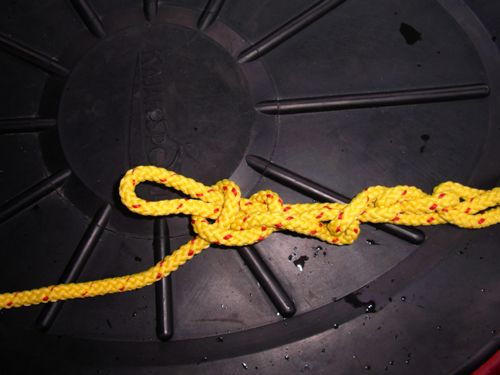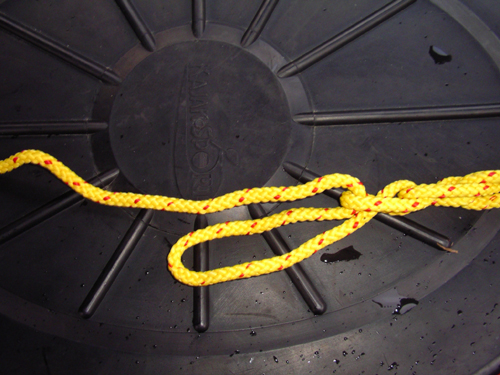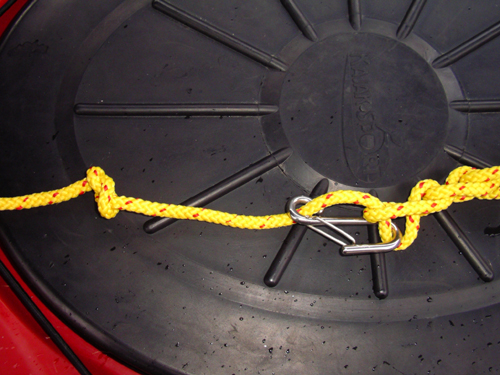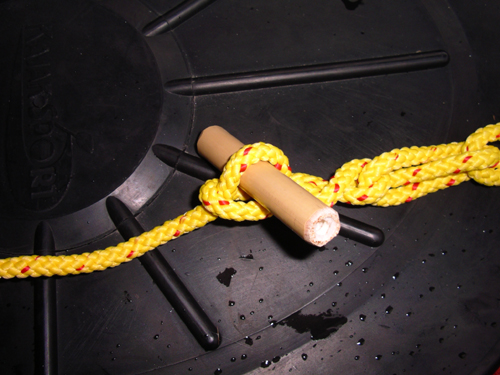Thoughts on using, stowing and deploying towlines and on making your own boat mounted tow system.
Making a Boat Mounted Tow Line

A simple, effective
tow line.
Go to |
||||
Traditional UK thinking seems to favour using braided, floating line such as is used for river rescue throw-bags and incorporating some form of shock absorber, usually in the form of a length of bungee cord – however, some of the proprietary lines are being made of ¼ in (6mm) floating polypropylene rope which has an inbuilt stretch factor, and, as mentioned earlier, the Aussies mention using 3mm cord.
You’ll also need a tow hook of some form and your line should ideally also incorporate a float at the hook end, as the line flotation won’t be enough to support its weight if it’s dropped in the water. The float is a "gill net float" and some chandlers and most fishing equipment suppliers will have them.
I recycled an old throw-bag line when making the line shown below.
|
|
|
|
| General layout –The orange sleeve’s purpose is to act as a “line marker” to make it easier to see in the water. The line is shown daisy chained here for stowing in a bag. |
Detail - showing the bungee inserted into the line, the U clips used to secure it and the heat shrink sleeve. Note line coiled round the bungee. The knot stops the float moving. |
Towing hook – a large karabiner taken from a “cows-tail” on a river ba – the notch has been removed to prevent it catching on deck or toggle lines when being unhooked. |

I use a "half fisherman's knot" to attach the line to the hook. There's a photo "how to" on my Photobucket here. The end is secured with a "common whipping", although electrical tape or heat-shrink sleeving will work fine too. Another way to attach the line to the hook is to seize it with whipping twine.
On the line shown, the bungee cord which acts as a shock absorber has been inserted into the core of the line and secured with stainless U clips, the joint is then covered neatly with “heat shrink” plastic sleeving intended to be used for whipping synthetic ropes. Both were obtained from a chandler.
The line wraps round the bungee, purely for neatness, and it’s important to make sure the line will tension before the bungee stretches to its limit. I don’t recommend cutting the line and tying the bungee into it as that creates the risk of the bungee breaking or knots coming undone.
I daisy chain the line to make packing in a bag easier – I’m aiming for “one action” deployment and have found (to my cost – see later) that the more complex one makes the system, the harder it is to deploy.
In my view, the end of the daisy chain is best set to be nearest to you so it can be reached and undone easily, although I also understand why Valley set their line up so that the end is at the tow-hook end. There are several ways to secure it.
|
|
|
 |
|
| This is the end of the daisychain. |
Using a small stainless steel clip to secure it. The figure 8 knot to the left is just to stop the clip falling off the end of the line when it's released from the boat. This has the disadvantage of limiting your ability to shorten the line by pulling it through the system of course, as the knot will foul on the bulls-eye. |
Using a clove
hitch. Very simple, although marginally less easy to undo than a
clip. |
A wooden peg - if you wanted to be really pedantic, you could always attach a bit of cord to it and tie to the line. Again, that will prevent easy shortening. |
On the subject of the tow hook itself, I've chosen the large alloy krab specifically to give me something big to grab. The downside of using an alloy krab is that it does require maintenance when used in salt water so if you go this route, I'd urge you to check and lubricate it frequently. I found that by a combination of rinsing it after use (I hose the boat down as a matter of course) and using Waxoyle on the hinge that it is still fine 10 years after being fitted. Other popular options include the large size, stainless steel Wichard hooks - or carbine hooks. Any decent chandler will have these and they can also be bought from Whetman Equipment. Plastic hooks are also available, but are quite bulky and some people feel they may be unreliable.
This particular line shown is just over 7 meters – that was dictated by the length of available rope when I made it and as it was originally just mounted down the side of the boat, that also constrained the length. Longer would be better – perhaps 15 to 20 meters.
You may also want to consider placing the float a bit further from the hook than is shown in the pictures - this allows two boats to be linked for towing, but also allows the supporter to slide forward and clear the tow. This discussion has details and pictures.
NOTE: Since the article was originally written, I've replaced the tow line illustrated with 20 mtrs of stretchy 5 mm floating line. It seems to have sufficient inherent elasticity not to need a bungee insert. It seems effective and having towed "for real" in challenging conditions I've not noticed any problems with not having the bungee. As the line is now so long, it is daisy-chained in the bag, and the chain is secured. There is also more line between the hook and the float.
Go to |
||||
~ The UK Rivers Guidebook and UK Sea Kayak Guidebook Websites, the home of UK paddling on the Net ~
COMMUNITY TRIPS ALMANAC CONTRIBUTE BOOKS RIVERS





